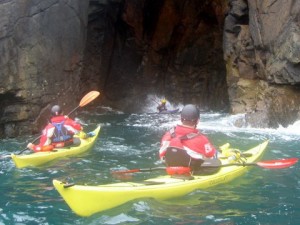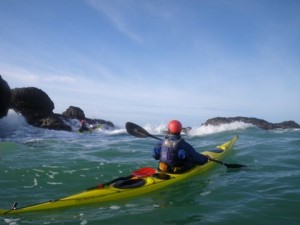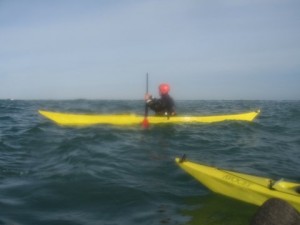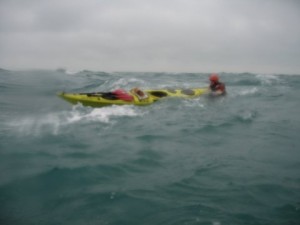Sea Kayak Incident Training. Communication,Line of Sight, Avoidance & Position (CLAP) for real
Sea kayakers in Jersey often go into rock gardens and sea caves. On BCU 3 star and 4 star leader training/ assessments and sea kayak safety courses I make a point of encouraging paddlers to consider some “ what if” situations and sea kayaking incidents.
Sometimes the sea kayaking on Jersey gets a bit challenging so it is important to ensure you have good communication and “what if” plans. This is why our courses at BCU 3 and 4 star level often play in rock gardens. It is also because sea kayak exploration of the coastline is a great thing to do and is also an excellent place to develop your paddle skills.
Even on our entry level courses it is clear that paddlers want to explore. This is a good reason to teach essential sea kayak skills and give sea kayakers the knowledge to be able to have great sea kayak trips around Jersey -and elsewhere- and know when and where to go sea kayaking.
It’s a good idea to paddle within your limits and to also have a bit in reserve in case things start to escalate. Plus, it’s good to know what to look out for so you know when to stay out. This happened last weekend when a cave looked okay to enter but we waited to see what was happening. A few minutes later and the cave was hit by a very large swell. I suspect we’d have been getting scraped off the ceiling, a bit like Tom in the cartoon series Tom & Jerry (for those old enough to remember this).
Rock Garden Rescue & Communication lessons learned. Video by Neptune’s Rangers
I found this sea kayak incident report and video of a sea kayaking in rock gardens incident. It is made by Neptune’s Rangers– who do some ‘interesting’ sea kayaking-. Some of what they do is similar to the sort of stuff our local paddlers -me included- get up to when out to ‘play’….
The blog and video is a very honest evaluation. They identify the importance of communication (and double checking the message is understood) in challenging conditions. This can easily break down in caves and rock gardens and caves.
Communication
On a 4 star sea kayak training we tested methods of communication in a cave and rock garden. Forget voice and use visual signals. Even that good old whistle we all carry is far more effective than lots of shouting. Just make sure all know what each blast of the whistle means!
Remember, if you use a whistle the get out blast should be a single long blast. If you opt for two or more short blasts there is a risk that paddlers will only hear the first blast. This could be embarrassing if they start heading in when you really wanted them to get out of there. This might be the moment you switch to plan B – providing you have discussed this in advance with the team.
I prefer clear visual signals.
The video shows dealing with a rescue, tow and landing on rocks for real ( now you know why landing on rocks is in 4* leader training -though this is a bit 4* plus I must admit). Watch out for the kayak nearly hitting the rescue kayaker in the rocks.
Know your kit
The type of kit used and paddlers overall feelings gets a mention in the video. Peter’s (the swimmer) comments are worth considering. However, he does not fall into the trap of blaming the kit. Instead he highlights the importance of being used to using the kit, some of which he’d not worn/used for a while. This raises a good point: When did we last practice our skills with our spare paddle? Or, is that spare bit of gear an older paddle/wetsuit which we are now less used to using?
There are lots of things for paddlers to consider and think about.
The comments by each paddler involved after the event are well worth reading. They think being a bunch of paddlers who often go afloat together might have been a factor.
Using CLAP for real
This is good opportunity for sea kayakers to consider how they might deal with an incident where Communication,Lline of sight, Avoidance and Position of most effectiveness (CLAP) have all become tricky. In this case the incident happens in just the very spot where CLAP principles are going to be tricky.
Sea kayak training courses
This is a good reason to get some training and practice in sea kayak leadership and incident management, even if it is not in such challenging conditions as this.
I often suggest to sea kayakers of all levels that they have some skills/experience always in reserve and they know their limits and what to look out for. A sea kayak training course is a good way to develop this.
Just make sure your sea kayak trainer/ course organiser is able to set things to your limits and skills sets and is not pitching the sea kayak course at their own level!
Derek Hairon




